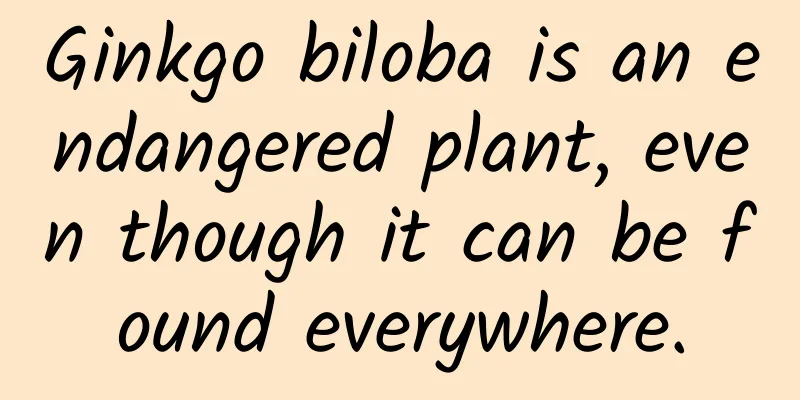Ginkgo biloba is an endangered plant, even though it can be found everywhere.

|
Review expert: Liu Xiaolu, Senior Engineer, Urban Construction (Beijing) Landscape Planning and Design Institute Co., Ltd. In quiet parks, in thousand-year-old temples, and on both sides of busy roads, several ginkgo trees are closely adjacent to each other. Their leaves are uniquely shaped, like delicate little fans, swaying in the breeze, adding a touch of coolness to the hot summer days. Image source: Qianku.com Ginkgo is often seen in our daily life. But do you know that this seemingly common tree is actually an endangered plant? If ginkgo becomes extinct, an entire plant class will disappear from the earth... 0 1 Living fossils in the plant world From a biological perspective, endangered refers to the survival status of plants in the wild environment, not including those artificially cultivated plants in your street or community. Therefore, the ginkgo we are talking about refers to "wild ginkgo". Image source: Science Popularization China Ginkgo is native to China. It is a relict species (i.e. a unique species or relict species from an ancient geological period) preserved after the Quaternary glaciation. It has undergone a long evolutionary history since its origin in the late Paleozoic Era and is known as the "living fossil" of the plant kingdom. The earliest fossils of Ginkgo can be traced back to 270 million years ago. According to fossil evidence, there were five families in the Ginkgoales, which were widely distributed on all continents of the world. When angiosperms rose rapidly in the Cretaceous period, Ginkgo also declined rapidly like other gymnosperms; after the Late Cretaceous period, Ginkgo plants other than Ginkgoaceae were basically extinct. Since the middle Pleistocene (580,000 to 140,000 years ago), the ginkgo has retreated again and again after experiencing multiple ice ages. Today, there are only three wild populations in eastern China (represented by Tianmu Mountain in Zhejiang), southwestern China (represented by Wuchuan in Guizhou and Jinfo Mountain in Chongqing), and southern China (represented by Nanxiong in Guangdong and Xing'an in Guangxi). 0 2 Are all existing ginkgo trees the same? Since most wild ginkgo populations are not in nature reserves, and ecological damage and human transplantation pose a serious threat to ginkgo, there have been no young trees naturally regenerated around many wild ginkgo trees for 10 years. In addition, most ginkgo trees used as urban street trees are "inbred", which cannot increase the genetic diversity of ginkgo. Today, ginkgo has really become a "lone hero" in the plant world. Therefore, the genes of ginkgo trees that can be seen everywhere in the streets and alleys are actually the same or similar. Image source: Qianku.com The existing ginkgo is the only remaining plant of the "Ginkgo class, Ginkgoales, Ginkgoaceae, Ginkgo genus, Ginkgo species". If ginkgo becomes extinct, the entire class will be extinct. Moreover, since the genes of currently cultivated ginkgo trees are no longer diverse, once a disease breaks out in nature that targets ginkgo, all ginkgo trees may die from viral infection. 0 3 The threat level is higher than that of the giant panda. Academician Zhou Zhiyan, a famous paleontologist, once said: "Ginkgo has actually entered a period of evolutionary decline. The decline of Ginkgo species and the reduction of wild distribution areas also indicate the decline of natural populations of Ginkgo." In 1999, Ginkgo was designated as a national key protected wild plant (first level). What is the concept of "national first-class key protected wild plants"? The giant pandas "Hua Hua" and "Fu Bao" that everyone loves are national first-class key protected animals. By analogy, you can understand how rare ginkgo is. Image source: IPANDA Among the species with extinction risk assessed by the International Union for Conservation of Nature (IUCN), the threat level of ginkgo is even higher than that of giant panda. In 2021, due to the effective improvement of wildlife habitats, the threat level of giant pandas was downgraded from Endangered (EN) to Vulnerable (VU): Image source: Screenshot from IUCN official website But currently Ginkgo is still in the endangered (EN) category: Image source: Screenshot from IUCN official website We look forward to hearing the good news about Ginkgo's "downgrading". 0 4 Every blade of grass and every tree is precious Ginkgo has witnessed the changes of the Earth for hundreds of millions of years. Its endangerment is not only a tragedy for a species, but also a loss for the entire ecosystem. It's not just the ginkgo, many other species are in danger. It's no exaggeration to say that biodiversity is facing serious threats. By the end of 2023, there were 157,190 species listed in the Red List of Threatened Species of the World Conservation Union (IUCN), of which 44,016 were on the verge of extinction. Today, humans have begun to pay attention to the survival status of these species. We believe that with our joint efforts, they can survive the crisis of extinction and continue to write the legend of life. |
<<: Fast for two days a week, is the 5:2 fasting method the “savior” for “fatty liver”?
Recommend
The efficacy and function of hairy stem Malan
Many people know that hairy-stem Amaranth has uni...
The efficacy and function of the root of Nvloucai
Chinese medicinal materials are very common, and ...
Are "panda eyes" caused by staying up late? Dark circles may be more complicated than you think...
gossip In daily life, dark circles are a problem ...
The efficacy and function of turban grass
I don’t know if you are familiar with the turban ...
How can we build an elevator to go to space and fix it to the rotating earth? There is no need to fix it
Space elevator, a concept that sounds very sci-fi...
Forward and collect! This knowledge can save lives at critical moments
Not long ago, three children were washed away by ...
Beware of flash floods! Two departments jointly issue orange flash flood disaster weather warning
The Ministry of Water Resources and the China Met...
The efficacy and function of Tian Eggplant
For Chinese medicinal materials such as Tian Qie ...
It costs tens of thousands of yuan to "start up" the machine once. What are the advantages of surgical robots?
Review expert: Shi Yunlei, PhD, Department of Inf...
What is Viola yedoensis
We don’t know much about many plants, but there a...
A man suddenly suffocated to death! Just because he ate "Lvdagun"? Urgent reminder!
Recently, a piece of news is very shocking: A man...
Which Chinese medicines can be used to soak in wine to nourish the kidneys
The pace of modern life is getting faster and fas...
The efficacy and function of Pedaloe vera
What are the effects of Pedulonella oleracea? As ...
The efficacy and function of ginger[picture]
Ginger [picture] is very familiar to everyone. Gi...
2023 Nobel Prize in Physiology or Medicine announced, related to COVID-19 vaccine
On October 2, at 11:45 CET (17:45 BJT), the Nobel...









